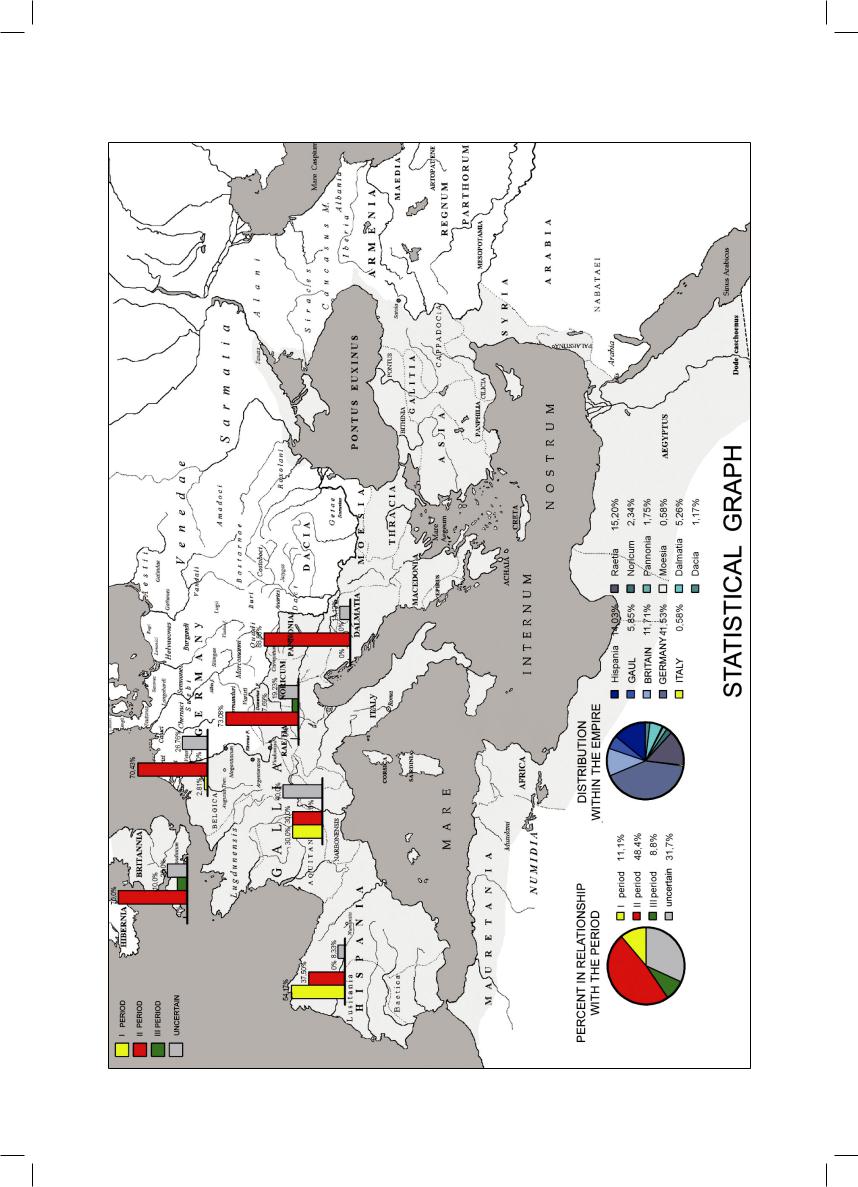
Pugio_-_Gladius_brevis_est
.pdf
CHAPTER IX - DATABASE OFARCHAELOGICALFINDINGS
STATISTICS
|
|
|
|
Number of specimens on regard the typology |
|
|
|
|
|
||||||
|
|
|
|
|
|
|
|
|
|
|
|
|
|||
|
|
|
|
I typology specimens: |
24 |
|
|
|
|
|
|
|
|||
|
|
|
|
II typology specimens: |
108 |
|
|
|
|
|
|
|
|||
|
|
|
|
III typology specimens: |
19 |
|
|
|
|
|
|
|
|||
|
|
|
|
unclassifiable specimens: |
68 |
|
|
|
|
|
|
|
|||
|
|
|
|
|
|
TOTAL |
219 |
|
|
|
|
|
|
|
|
|
|
Hispania |
|
Gaul |
|
Britain |
|
Germany |
|
Italy |
|
Raetia |
|
Noricum |
|
|
|
|
|
|
|
|
|
||||||||
|
typology I |
13 |
|
3 |
|
0 |
|
2 |
|
0 |
|
0 |
|
0 |
|
|
typology II |
9 |
|
5 |
|
14 |
|
50 |
|
0 |
|
19 |
|
0 |
|
|
typology III |
0 |
|
0 |
|
2 |
|
0 |
|
0 |
|
2 |
|
3 |
|
|
uncertain |
62 |
|
4 |
|
4 |
|
19 |
|
1 |
|
5 |
|
1 |
|
|
total |
24 |
|
11 |
|
20 |
|
71 |
|
1 |
|
26 |
|
4 |
|
|
|
Pannonia |
|
Moesia |
|
Dalmatia |
|
Greece |
|
Asia |
|
Africa |
|
Dacia |
|
|
|
|
|
|
|
|
|
||||||||
|
typology I |
0 |
|
0 |
|
0 |
|
0 |
|
0 |
|
0 |
|
0 |
|
|
typology II |
1 |
|
0 |
|
8 |
|
0 |
|
0 |
|
0 |
|
0 |
|
|
typology III |
0 |
|
1 |
|
0 |
|
0 |
|
0 |
|
0 |
|
0 |
|
|
uncertain |
2 |
|
0 |
|
1 |
|
0 |
|
0 |
|
0 |
|
2 |
|
|
total |
1 |
|
1 |
|
9 |
|
0 |
|
0 |
|
0 |
|
2 |
|
131
Libro inglese BAR [A4].indd |
131 |
27/05/2012, 16.25 |

PUGIO - GLADIUS BREVIS EST
132
Libro inglese BAR [A4].indd |
132 |
27/05/2012, 16.25 |

CONCLUSIONS
At the end of the course of study of our weapon what ultimately emerges is that it is one of the fruits of the exceptional pragmatism of the RomanArmy.
In fact,we noticethatas far as “when” is concerned,it was exclusivelyused during the period itwas useful to them;as far as “where” is concerned, it was used in the territories in which the miles confronted enemies who made its use efficient; finally, as far as “who was equipped with it” is concerned, we have pointed out that only those soldiers possessed it who had real necessity to use it in combat.
Every element converges in its practicality and in the maximization of its use, which is at the base of both our weapon and the RomanArmy.
Consideringtheremarkableamountofinformationwhichhasarisen,wewouldliketoconcludebysummarisingthemain points:
●from a historical point of view:
-Its roots are to be found directly in the Celtiberian bi-globular dagger;
-ItfirstappearedattheendoftheIIcenturyB.C.,probablywithinthecohortallegion,asaresponsetothenecessity to optimise the individual armament of the legionary, with its period of maximum splendour and diffusion around the I centuryA.D.;
-Duringthehistoricalperiodofitsexistenceitevolvedinthreemaintypes:theI(orRepublican),theII(orImperial) and the III (or final);
-Its efficiency was such that it became proverbial in time, and writers both of the time and subsequently used it as an example of infallibility;
-It was not equally distributed in all the provinces of the Empire, but almost exclusively concentrated in those which confined with populations of Celtic/Germanic stock (Rheine-High Danube limes and low Britannia) while virtually absent in almost all the others;
-Only the legionary and auxiliary heavy infantry were equipped with it and, in the military hierarchy, only to the rank of centurion;
-Its main function was that of a war weapon, complementary to the gladius, to be used in situations of close combat and against the type of enemy who made it useful;
●from a technological point of view:
-Two main types of construction technology can be identified: “composite” and “tight insertion”;
-“Composite” technology was particularly complex, to the point of being typical only of this weapon, with the only exception being the Celtiberian dagger from which it descended;
-The blades were of a rather small size at first, but they progressively increased until they became very long and exceptionally wide;
-During the Republican and final period the weapons and their sheaths appeared austere and plain; in the Imperial Age, instead, they were richly decorated, even with precious materials;
-Its decoration during Period II, above all on the sheaths, often had a specific symbolic meaning or one of political propaganda;
133
Libro inglese BAR [A4].indd |
133 |
27/05/2012, 16.25 |

PUGIO - GLADIUS BREVIS EST
134
Libro inglese BAR [A4].indd |
134 |
27/05/2012, 16.25 |

BIBLIOGRAPHY
●Classical Bibliography (limited to the authors not dealt with in Chap. “VIII – Classical Bibliographical Citations”)
-AMMIANUS MARCELLINUS: Res Gestae
-APPIANUSALEXANDRINUS: Storia Romana
-ARRIANUS:Ars Tactica
-JULIUS CAESAR : De Bello Gallico
-JULIUS CAESAR: De Bello Civili
-JOSEPUS FLAVIUS: De bello Judaico
-LUCIUS CASSIUS DIO COCCEIANUS: Roman History
-MAURICE: Strategikon
-ONASANDRUS PLATONICUS : Strategikon
-POLIBIUS: Historiae
-SALLUSTIO GAIUS CRISPUS: Bellum Iugurthinum
-SEXTUS JULIUS FRONTINUS: Stratagemata
-TACITUS : Historiae
-TITUS LIVIUS: Ab Urbe Condita Libri
-VEGETIUS FLAVIUS RENATUS: Epitoma Rei Militaris
● Contemporary Bibliography
ON THE WEAPONARY OFTHE ROMANARMY, with particular reference to edge weapons
-AIELLO V., “le armi nel mondo tardo antico”;
-ALPTEKIN ORANSAY, “Roman military equipment at Arycanda”, J.R.M.E.S. 12/13, 2001-2002;
-ADCOCK F., “The roman art of war under the Republic”, Cambridge Mass. 1940;
-BANDINELLI R. BIANCHI, “Il Maestro delle imprese di Traiano”, ed Electa, 2003;
-BIRBOSKI M., “Typologie und chronologie der ringknaufschwerter”;
-BIRBOSKI M, “Römische Schwerter im Gebiet des europäischen Barbaricum”, J.R.M.E.S.,5, 1994;
-BISHOP M.C., “Excavation at roman Corbridge, the Hoard”, HBMCE, archeological report n. 7;
-BISHOPM.C.,“The military fabrica and the production of arms in early principate”, 1985;
-BISHOP M.C., “cavalry equipment of the Roman army in the first century A.D.”, 1988,
-BISHOP M.C., “a decorated dagger scabbard from Corbridge, Northumberland”, arma 1,20,
-BISHOPM.C.,“anew flavian military site at Roecliffe”,
Brit XXXVI;
-BISHOP M.C. & J.C. COULSTON, “Roman Military Equipment from the Punic wars to the fall of Rome” ,
Oxbow Book;
-BONNAMOUR L., “un poignard romain trouvè dans la Saone” , Gallia 27 pag 178-185;
-BONNAMOUR L., “Les armes romaines de la Saône: état des découvertes et données récentes de fouilles”, J.R.M.E.S.,5, 1994;
-BOUBE-PICCOT, C., »Les bronzes antiques du Maroc, 4. L’équipment militaire et l’armament » Paris:Éditions Recherches sur les Civilisations,1994 ;
135
-BRIZZI G., « Il guerriero, l’Oplita, il Legionario » Ed. Il Mulino , 2002 ;
-BROUQUIER-REDDÈ V. ,”L’ equioment militaire d’ Alèsia d’ après les nouvelles recherches” , Journal of Roman Military studies, st.8 1997;
-Cagniart P.,”The late republican army (146-30 BC)”. In: Erdkamp, P. (a cura di), A companion to the Roman army, Chichester: Blackwell Publishing, 2011;
-Carrié J-M., “Il soldato” (traduzione F. Gonnelli). In: Giardina, A. (a cura di), L’uomo romano, Roma-Bari, ed. Laterza,1993.
-Cheesman G.L., “The auxilia of the Roman imperial army”, Roma, ed. L’Erma di Bretschneider, 1968;
-CONNOLY P. “Greece and Rome at war”; ed Greenbooks;
-CONNOLY P., “Pilum, gladius and pugio in the late Republic”, Journal of Roman Military Equipment Stdies, n. 8, pag. 41-57;
-CONNOLY P., “The roman fighting technique deduced from armour and weaponry”, Roman Frontier Studies, Exeter, 1989;
-CORNELL T. , “The beginnings of Rome. Italy and Rome from age to the Punic wars”,Londra 1995;
-COULSTON C., “Military equipment and Identity of Roman soldier s. Proceedings of the fourth Roman Military equipment conference”, BAR 394;
-COUSSINP.,“Lesarmesromaines:essaisurlesorigins et l’ evolution des armes individuelles du legionnaire romain”, Paris, Honorè Champion, pag. 302-313;
-COWAN ROSS, “Roman legionary 58 B.C. – AD 69”,
Osprey;
-CZARNECKA K.: “Two newly-found roman swords from the Preworsk culture cemetery in Oblin, Siedlce District, Poland”, J.R.M.E.S 3, 1992;
-D’Amato R. e Sumner G.,”Arms and armour of the imperial Roman soldier. From Marius to Commodus, 112 BC – AD 192”, London, ed. Frontline Books. 2009;
-DAWSON M., “a review of the equipment of the roman army of Dacia”, in Roman Military Equipment: the source of evidence, BAR International series, 476;
-DOBSON B., “The Roman army: wartime or peacetime army?”, In: Eck, W.; Wolff, H. (a cura di), Heer und Integrationspolitik. Die römischen Militärdiplome als historische Quelle, Köln: Böhlau, 1986;
-DurryM.,”Les cohorts prétoriennes”,Paris:Éditionsde Boccard, 1938;
-DUVALA.,Les armes deAlèsia au musèe delAntiquitès nationales’. Rev. Hist. DesArmèes 2, 1987;
-EDIT B. THOMAS, “Helme, schilde, dolche”, Akademiai Kiado, Budapest;
-EXNER K., “Rőmische Dolchsheiden mit Taushieren und Email-verzieerung”, Germania 24, pag. 22-28;
-FEUGERE M., “Weapons of Romans”, ed. Tempus, 1997 – 2007. 1, pag. 99-107;
-FEUGERE M. “L’equipment militaire d’époque républicaine en Gaule”, J.R.M.E.S 5,1994;
-FEUGEREM.“Les armes des romains de la République a l’antiquité tardive”, Paris;
-FEUGERE M., “L’Equipement militarire romain dans le Départment de la Loire”, Cahiers Arcélogiques de la Loire, 3;
-GERHART-WITTEVEEN A. M., “Survey of sword and daggers in the Provinciaal Museum G.M. Kam, Nijmegen”, Journal of Roman Military Equipment
Libro inglese BAR [A4].indd |
135 |
27/05/2012, 16.25 |

PUGIO - GLADIUS BREVIS EST
Studies;
-GOLDSWORTHY ADRIAN, “Storia completa dell’ esercito romano”, Logos;
-GOLDSWORTHY ADRIAN, “Roman warfare”, Londra 2000;
-GOLDSWORTHYADRIAN, “The roman Army at war, 100 b. C. – 200 a.D.”, Oxford 1992;
-GONZALEZ J.R, “Historia del las legiones romanas”, Madrid 2003;
-GRIFFITHS N. A., “a gladius from Dorset, in the Ashmolean Museum”, Britannia, 10, 1979;
-H. RUSSELL ROBINSON, “The armour of Imperial Rome”, ed. Purnell Book Service,1975;
-HAZELL P. “The pedite gladius , The Antiquaries Journal”, 1981, vol. 61 , pagg. 73-83;
-HOLDER P., “Studies in the auxilia of the roman army from Cesar to Traian”, BAR 70;
-IBAŇEZ C. F., “Equipamiento armamentisco del legionario altoimperila”, Espacio,Tiempo y forma, Serie II, Historia antigua, t. 16, 2003;
-ISTENIČ J., “A roman late-republican gladius from the river Ljubljanica (Slovenia),Arheološki vestnik, 51, 2000;
-JAMES S., “Excavation at DuraEuropos 1928-1937: final report”, London;
-JIMENO A., “Numancia, Guìa del yacimiento” Soria, Asosacion deAmigos del Museo Numantino;
-JUNKELLMANN M., “Panis militaris: die ernahrung des romischen soldaten oder der grundstoff der macht”,
Mainz am Rhein 1997;
-KAVANG DE PRADO E. & QUESADA SANZ F., “Pugio Hispaniensis between Celtiberia and Rome. Current research and analysis of the costructionot the sheats”, inLimesXX,Proceedingofthe20th international congress of Roman Frontier Studies, Leon, 2006;
-KAZANSKI M.; “L’equipment et le matériel militaires au Bas-Empire en Gaule du nord et du l’est”, Revue du Nor-Archeologie, 57;
-KAVANG DE PRADO E. & QUESADA SANZ F., “Pugio Hispaniensis between Celtiberia and Rome. Current research and analysis of the costructionot the sheats”, in Limes XX, Proceeding of the 20th international congress of Roman Frontier Studies, Leon, 2006;
-KEPPIE L., “The making of Roman army from Republic to Empire”, London 1984;
-KREKOVIC E., “Military equipment on the territory of Slovakia”, Journal of Roman Military Studies, n. 5, pag. 211-225;
-LE BOECHY., “l’esercito romano, ed. Carocci;
-LE BOECH Y., “L’Armée romaine sous le HauteEmpire”, Paris;
-LE BOHEC Y., « Armi e guerrieri di Roma antica. Da Diocleziano alla caduta dell’impero” (traduzioneL.Del Corso), Roma, ed.: Carocci, 2008 ;
-LE BOECH Y., “The Imperial Roman army”, Londra
– NewYork 1994;
-LE BOHEC Y. «L’armement des Romains pendant les Guerres Puniques d’après les sources littéraires», Journal of Roman Military Equipment Studies, 8, 1997 ;
-LIBERATIA.ESILVERIOF.,“Organizzazionemilitare, esercito”, vol. 5 del Museo della Civiltà Romana,1988;
-LUDWIG V. BERGHE, “some roman military
equipment of the first three centuries AD in Belgian museums”, J.R.M.E.S. 7,1996;
-MANNING W.H., “Catalogue of the Romano-British iron tools, fittings and weapons in the British Museum”, London, British Museum Publications, 1985;
-MATYSKAZ P., “I grandi nemici di Roma Antica”, ed. New Compton , 2007;
-MC CARTENEY E., “The military indebtenes of early Rome to Etruria”, Memories of theAmericanAcademy at Rome, 1917;
-MIKS C., “Berlegungen zur roemischen schwertausruestung in der zeit karkomannnenkriege”;
-NIGELMILLS, “Celtic and romans artifact”, Essex;
-NYLÈNE.,“EarlygladiusswordfoundinScandinavia”, ActaArchaelogica XXXIV, 1963;
-OBMANN J.: “ Zu einer elfenbeinernen dolchgriffplatte aus Nida-Heddernheim/frankfurt am Main”, J.R.M.E.S 3, 1992;
-OBMANN J. (2000), “Studien zu römischen Dolchscheiden des 1Jahrhunders n. Chr.”, (Kölner Studien zurArchaologie der Römischen Provinzen, Band 4). ISBN: 3-89646-132-X;
-PETCULUSCU L.,”bronze miniature weapons and armour in the equipment of roman soldiers from Dacia in the second and third century a.D.”, Acta of the 12th international congress of ancient bronze in Nijmegen, 1995;
-QUESADA F., “Gladius hispaniensis:: an archeologic view from Iberia”, JRMES 1997, vol. 8;
-RADMAN-LIVAJAIVAN,“MilitariaSiscensia”,Musei archeologici Zagrabiensis Catalogi et monographiae;
-RALD ULLA, “the swords from Danish bog finds”, J- R.M.E.S., 5, 1994
-RANKOV B., “The pretorian Guard”, London;
-RICHMOND I., “Traiana’s army on Traian’s Column”,
Londra, 1982;
-SCHULTEN A., “Numantia. Die ergebnisse der Ausgrabungen 1905-1912”, Munich, 1914-1931;
-SCOTT IAN R.. “First century military daggers and the manufacture and supply of weapons for the Roman army”. In: Bishop, M.C. (a cura di), The production and distribution of Roman military equipment. Proceedings of the second Roman military equipment conference, BritishArchaeological Reports;
-SCOTT IAN R, “Military equipment and the roman army in London”, J.R.M.E.S. 1;
-SEKUNDAN., “Republican roman army 200-104 BC”, ed.. Osprey;
-SIMD.,“The manifacture of disposable weapons for the roman army”, J.R.M.E.S., 3, 1992;
-SIMON TIMOTHY J., “The arms and armour from Dura Europos, Syria”;
-SIMPSONG.“Romanweapons,tools,bronzeequipment and brooches from Neuss-Novaesium excavations 19551972”, British Archaeological Reports, International series, 862, Oxford: ed.Archaeopress, 2000;
-SOUTERN P. , “The late roman army” , London 1996;
-STEPHENSON I.P., “Roman-Byzantine Infantry Equipment”, Tempus;
-STEPHENSON I.P., “Roman Infantry Equipment, the Later Empire”, Tempus;
- THIEL A. & ZANIER W., “Römische dolche
– Bemerkungen zu den Fundumständen”, J.R.M.E.S. 5,1994;
136
Libro inglese BAR [A4].indd |
136 |
27/05/2012, 16.25 |

BIBLIOGRAPHY
-ULBERT G., “Straubing und Nydam . Zu romischen Langschwertern der spaten Limeszeit”, Munich 1974;
-ULBERT G., “Der Legionarsdolche von Oberammergau” inAus Bayerns Frühzeit. Festschrift F. Wagner, Monaco;
-ULBERT G., “Galdii aus Pompeji”, Germania, 47;
-UNZ C., “Römische militärfunde aus BadenAcquae Helvetica, Jahresbericht Gessel. Pro Vindonissa, 1971;
-VANDRIELMURRAYC.,“Roman Military equipment , the source of evidence.. Proceedings of the fifth Roman Military equipment conference”, BAR 476;
-VENDEN L. BERGHE & M. SIMKINS, “ construction and recostruction of the Titelberg dagger”, JRMES 12/ 13, 2001;
-WESTPHAL H., “Ein römischer Prunkdolch aus Haltern”;
-YPEY J., “drei römische Dolche mit tauschier-ten Scheiden aus niederländischen Sammlungen”, Ber Amersfoort, 10-11;
ON THE CELTIBERIAN WEAPONS, seen as prototype of the roman pugio
-ALONSO G., “Sobre el hallzago de un puńal biglobular enMonteCildà: La panoplia militar indìgena al servicio del Roma”, Sautuola,X: 35-45;
-ARGENTE O., “la necròpolis de Carratiermes “,Il simposio sobre los celtìberos, 1988, pag. 51-58;
-ARTINANO Y GALDACANO: “Exposiciòn de hierros antiguos espańoles; catalogo (Madrid), 1919;
-BANFI G., “L’armamento dei Celti”, ed. Il Cerchio;
-BELLIDO G., “puňal romano de Iuliòbriga”, Archivo Espaňol deArqueologia, 36, pag. 200-201;
-BORN H. & SVEND H., “Helme und waffen alteuropas”, sammlungAxell Guttmann;
-BLAZQUEZ, J.M.; GARCIA-GELABERT, M.P,
“Estudio del armamento prerromano en la Península Ibérica a través de las fuentes y de las representaciones plásticas”. HispaniaAntiqua, 14, 91-115, 1990;
-BRONCANO S., “La necrópolis ibérica de El Tesorico (Hellín, Albacete)”. Noticiario Arqueológico Hispánico 20, 43-183,1985;
-BRUHN DE HOFFMAYER, A.,”Arms and armour in Spain”. Madrid,1972;
-CABRE A. J., “La caetra y el scutum en Hispania durante la Segunda Edad del Hierro”, bseaa 6, 57-83, 1939-40;
-CABRE A. J.,”El saludo ibérico, saludo racial precursor del nacional. Su difusión por Europa en unión del gladius hispaniensis”, Revista de Coleccionistas y Curiosos. XIX, núm. 196, 21-31,1943;
-CABRE A., “ tipologìa del puńal en la cultura de Las Cogotas”, Archivio Espanôl del Arte y Arqueologia”, 21, pag. 222-223;
-CABRE A.,”El castro y la necròpolis del hierro cèltico de Chamartìn de la Sierra”, Madrid, Ministerio De educacion Nacional, 1950;
-CABRE A.,”datos para la cronologia del puňal de la culturadelaCogotas”,ArchivioEspanoldeArqueologia, 24, pag. 37-47, 1933;
-CABRE DE MORAN M.E., “Espadas y puñales de las necrópolis celtibéricas”. Necrópolis Celtibéricas. II Simposio sobre los celtíberos, Zaragoza, 205-224, 1990;
-CABRE DE MORAN, M.E., “Notas para el estudio de las espadas de tipoArcóbriga”,EncuentrodeHomenaje. Zaragoza, 151-162, 1984;
-CABRE DE MORAN M.E, “Espadas y puňales de la
Meseta Oriental en la II etad del hierro”, Celtiberos, Diputacion provincial de Zaragoza, 123-126, 1988;
-CABRE HERREROS :”puňale dobleglobulares con provale simbologia astral en el pomo de la empuňatura”, XX Congreso Nacional deArquelogia, pag. 341-346;
-CHAIN GALAN: “Celtibèros. Tra las estelas de Numancia.”, Soria , Junta de Castilla y Leon, 2005;
-COLLINS J., “The Celts, origin, myths, invention”,
London, Tempus, 2003;
-CUADRADO, E., “La panoplia ibérica de Murcia”, 1989;
-CUADRADO D., “La panoplia ibérica de “El Cigarralejo” , Documentos: SerieArqueología, Murcia, 1989;
-CUNLIFFE B., “The Ancient Celts”, Oxford University Press, 1997;
-DE LA CHICA G, “El armamento de los Iberos”, Revista de Archivos, Bibliotecas y Museos, 63.1, 309321, 1957
-DE NAVARRO J.M., “Find from the site of La Tene” ,Oxford University press, 1972;
-DE PRADO E. KAVANGH, “el puńal biscoidal peninsular : tipologìa y relacion con el puńal militar romano (pugio)”, Gladius, pag. 5-85, 2008;
-DUVALP. M., “I Celti”, Rizzoli;
-FILLOY NIEVA, “las armas de las necròpolis celtibèricas de Carasta y La Hoya. Tipologia de sus puňales y prototipos del pugio”, Journal of Roman Military Studies n. 8, pag. 137-150, 1997;
-FILLOY NIEVA, “los puňales con eňpunadura globular de fronton en la necròpolis de la II edad del hierro de la Hoya”, Gladius, XXII pag. 57-72;
-GARCIA-GELABERT M.P.,”Estudio del armamento prerromano en la Península Ibérica a través de los textos clásicos”, Espacio, Tiempo y Forma, II, 69-80, 1989;
-GIANADDA R., “Celti, Germani e Vichinghi”, Mondadori Electa;
-IBANEZ CARMELO FERNANDEZ, “Las dagas del ejército altoimperial en Hispania”, Gladius XXVIII, 2008;
-LENERZ DE WILDE, M.,”Art celtique et armes ibèriques”,Aquitania, Suppl. 1, 273-280, 1986;
-MORILLO A. &JOAQUIN AURRECOECHEA, “The roman army in Hispania”;
-NIETO G. Y, ESCALERA A.,”Estudio y tratamiento de una falcata de Almedinilla”, Informes y trabajos del Instituto de Restauración y Conservación, 10, 1970;
-NAVASCUES E., “Dos falcatas ibèricas y un puňal de la provincia de Càceres en el Museo Arquelògico provincial del badajoz”, Revista de Estdudios Extremenos ,33,1, pag. 47-56;
-PINTA J. L.,”Yacimientos arqueològicos de Camporrobles y areas cercanas”, Cuadernos de Prehistoria y arquelogia castellonenses, 13, pag. 291332;
-QUESADASANZ F., “Armamento, Guerra y Sociedad en la necrópolis ibérica del Cabecico del Tesoro (Mula, Murcia, España)”. BAR International Series, 502. I-II. Oxford, 1989;
-QUESADA SANZ F.,”Armamento de supuesta
137
Libro inglese BAR [A4].indd |
137 |
27/05/2012, 16.25 |

PUGIO - GLADIUS BREVIS EST
procedencia meseteña en las necrópolis ibéricas de Murcia”. Necrópolis Celtibéricas. II Simposio sobre los Celtíberos. Zaragoza, 231-240, 1990;
-QUESADA SANZ F.,”Machaira, kopis, falcata”, ed. Dona Ferentes. Homenaje a F. Torrent. Madrid, 7594,1994;
-QUESADA SANZ F., “Arma y símbolo: la falcata ibérica”, Instituto de Cultura Juan Gil-Albert, Alicante, 1992;
-QUESADASANZ F.,”Algo más que un tipo de espada: la falcata ibérica”.CatálogodelaExposición:Laguerra en laAntigüedad. Madrid, pp.196-205, 1997;
-QUESADASANZF.,”Una sepoltura con arnas de baja época ibérica “, “Gladius”, vol. XX, 2000;
-QUESADA SANZ F., “El armamento ibérico. Estudio tipológico, geográfico, funcional, social y simbólico de las armas en la Cultura Ibérica (siglos VI-I a.C.)”, 2 vol., Monographies,1997;
-QUESADA SANZ F., “ Armas de la antigua Iberia, de Tartetos a Numancia”, la Esfera de los Libro;.
-SANDARS H.,”The weapons of the Iberians”, Archeologia 25,Oxford,1913;
-SIMON J., “the Atlantic Celts”, London , Brtish Museum press, 1999;
-SIMON J., “Britain and the Celtic iron age”, Brtish Museum press, 1997;
-SCHULTEN A., “Las Guerras de 154-72 a.C”, Fontes HispaniaeAntiquae, IV. Barcelona, 1937;
-STARY P., “Keltische waffen auf der Iberischen Halbinse”, Madrider Mitteilungen 23, 114-144;
-VITALE D., “I Celti”, ed. White Star, 2007;
-KOCK J, “Celtic Culture”,ABC Clio;
ONANCIENT METALLURGY
-AIMÈ BOCQUET,”metallurgia e relazioni culturali nell’ età del bronzofinale delle Alpi del Nord francesi”, ed.AntropologiaAlpina, 1983;
-BINAGHI R., “la metallurgia ai tempi dell’ Impero Romano”, ed. Istituto Romano di Studi Romani;
-CAVALLINI m., “fortuitum et sordidum opus, appunti di storia della metallurgia”, ed. Crace;
-COLMENERO A. R. & AVELAIRA T. V., “Equipamento militar del campamento romano de Aquae Querquennae”, J.R.M.E.S 7, 1996;
-CUCINI TIZZONI C., “il ferro nelle Alpi, miniere e metallurgia dall’ antichità al XVI sec.”, ed. Comune di Bienno;
-Caley E.R., “Orichalcum ad related ancient alloys”;
-FERNÁNDEZ J. A.,”Analysis of metallic composition and the process of production” in “Bronze studs in roman Spain”, J.R.M.E.S 7, 1996;
-FORMIGLI E. “antiche officine del bronzo:materiali , strumenti, tecniche.” Ed. Nuova Immagine NIE;
-FORBERS R. J., “ Metalllurgy in antiquity: a notebook of archaelogists and technologists”, Leiden 1950;
-FORBERS R. J., “Studies in Ancient Technology: Metallurgy in Antiquity - Copper and Bronze, Tin, Arsenic, Antimony and Iron (Studies in Ancient Technology)”,BrillAcademic Pub 1997 ;
-FRANCOVICH R., “Archeologia delle attività estrattive e metallurgiche”, ed. All’ Insegna del Giglio, 1993;
-GIARDINO C., “I metalli nel mondo antico: introduzione all’archeometallugia”, ed. Laterza;
-GRACIA A.,”elementos metàlicos de tipo celtibèrico: la colleciòn Pèrez Aguilar”, Il simposio sobre los celtìberos, 1988, pag. 287-304;
-HEALY JOHN F., “miniere e metallurgia nel mondo greco e romano”, ed. L’Erma di Bretschneider;
-KMETIČ D & J. HORVAT, F. VODOPIVEC,
“Metallographic examinations of the roman Republican weapons from the hoard from Grad near Šmihel”, 2004;
-LANG J., “ Study of the metallography of some Roman sword”, Britannia 19,1988;
-LODEWIJCKX M., WOUTERS L., SCHUERMAN E.: “A third century collection of decorative objects from a roman villa at Wange: second interdisciplinary report”; J.R.M.E.S. 7, 1996;
-MADRONERO DE LA CAL, “Estudio enstructural comparative entre piezas metálicas aparecidas en los yacimentos tardoromanos de Getafe (Madrid)”, Boletìn del museo arqueológico nacional, 3, 1985;
-MINTO A., “L’ antica industria mineraria in Etruria”,
Studi Etruschi 1954;
-PANSERI C., “La tecnica di fabbricazione delle lame d’ acciaio presso gli antichi”, Associazione Italiana di Metallurgia, 1957;
-QUESADA SANZ F., “not so different: individual fighting techniques ans small unit tactics of roman and iberian armies”, Pallas,70, 2006;
-RADOMIR PLEINER, “Iron in archeology: the europesn bloomery smelters”, Archeologicky Ustav Avcr;
-SCOTT D.A., “Metallography and Microstructure of ancient and historic metals”, The Getty Conservation Institute LosAlamos, California, 1991;
-SIM D.,”Iron for the eagle: the iron industry of roman Britain” ,Tempus;
-SIM D., “ the manufacture of disposable weapons for the roman Army”, J.R.M.E.S 3, 1992;
-ŠMIT ŽIGA, “Analysis of copper-alloy fitments on a roman gladius from the river ljubljanica”, Arheološki vestnik, 51, 2000;
-TYLECOTE R.,”Early history of metallurgy in Europe” , ed. Longman Group;
-TRIPATHIV.,“History of the Iron Technology in India”, ed. Rupa, 2008;
ON ROMAN SYMBOLOGY
-BIANCHI BANDINELLI R., “Roma, l’arte romana nel centro del potere”, Ed. Rizzoli;
-CATTABIANI A. & FUENTES M.C., “Bestiario di Roma”, ed. Newton Compton;
-CECCHERELLI M. I., “Il vento d’oriente – alla scoperta delle radici della cultura occidentale”, Ed. IEI, 1989;
-CHEVALIER J. & GHEERBRANT A., “Dizionario dei Simboli – miti, sogni, costumi, gesti, forme, figure, colori, numeri”, ed. BUR Rizzoli;
-CHINI P, “Vita e costumi dei romani antichi”, n°9, “La religione”, ed. Quasar, 1990;
-DI DARIO B., “La Notitia Dignitatum, immagini e simboli del Tardo Impero Romano”, edizioneAr.;
-GUÉNON RENÉ, “I simboli”, ed. Garzanti;
-GUÉNON RENÉ, “Il Regno della Quantità e i Segni dei
138
Libro inglese BAR [A4].indd |
138 |
27/05/2012, 16.25 |

BIBLIOGRAPHY
Tempi”, Milano 1982.
-GRIMALP.,“Mitologia - I miti greco-romani raccontati da Pierre Grimal”, ed. Garzanti;
-HOPEM.V.,”Trophies and Tombstones commemorating the roman soldiers”,WorldArchaelogy, 35, 2003;
-IMPELLUSO L., “dizionari dell’arte – la natura ed i suoi simboli”, ed. Electa;
-JOCELYN M. C. TOYNBEE, “Morti e sepoltura nel mondo romano”, ed. L’Erma di Bretschneider;
-KÜNZL E. “Dekorierte gladii und gingula: Eine ikonografische statistik”, J.R.M.E.S 5,1994;
-SIGHINOLFI C., “I guerrieri lupo nell’Europa arcaica. Aspetti della funzione guerriera e metamorfosi rituali presso gli indoeuropei”, Rimini 2004;
-WOOD D.,”The Scolae Palatinae and the Notitia Dignitatum”, J.R.M.E.S 7, 1996;
ON THE ROMAN MILITARY STELAEAND VARIOUS ICONOGRAPHS
-ALSTAIR SCOTT A., “Roman Military Tombstone”, ed. ShireArchaeology;
-CUMONT F., “After life in roman paganism”, 1959;
-BIANCHI BANDINELLI R.,”il maestro delle imprese di Traiano”, Electa, 2003;
-FARINELLA V.,” La colonna Traiana: un esempio di lettura verticale”, in Prospettiva, 26, 1981;
-FRANZONI C., “Habitus atque Habitudo Militis, monumenti funerari di militari nella Cisalpina romana”, ed. “L’Erma” di Bretschneider;
-FRANZONI C., “Il monumento funerario patavino di un militare e un aspetto dei rapporti artistici tra zone provinciali”, rivista di archeologia, 6;
-KOS M.S., “A latin epitaph of a roman legionary from Corinth”, Journal of roman studies, 68;
-POLITO E., “I fregi d’armi del Foro di Traianao. La base della colonna e i pannelli nella storia del motivo”, in I luoghi del consenso imperiale. Il foro diAugusto. Il foro di Traiano. Catalogo della mostra, Roma, 1995;
-POLITO E., “Fulgentibus armis. Introduzione allo studio dei fregi d’armi antichi”, in Xenia Antiqua, 4, 1998;
-RINALDI TUFI S., “Militari romani sul Reno”, ed. Giorgio Bretschneider;
-TOYNBEE J. M., “ Art in roman Britain”, 1963;
-TOYNBEE J. M., “ Art in Britain under the Romans”, 1964;
-TOYNBEE J. M., “Death and burials in the roman world”, 1971;
-ZANKER P., “Das Trajans forum in Rom”,
ArchaologischerAnzeiger,85, 1970;
CATALOGUES
Inside which images and information regarding pugiones, gladi, spathae and contemporary European swords can be found.
-BRITISH MUSEUM: British Iron Age Sword And Scabbard, 2006;
-BRITISH MUSEUM: Prehistoric Metal Artifact from Italy, 2007;
-CHAPMAN E. M., “A catalogue of Roman military equipment in the national museum of Wales” BAR, 2005;
-auction house CHRSTIE’S “ The art of warfare , The Axell Guttmann Collection part I , 6 novembre 2002;
-auction house CHRSTIE’S , The Axell Guttmann Collection of ancient arms and armours, part. II, 28 aprile 2004;
-auction house HERMANN HISTORICA, asta n. 47, 2004;
-auction house HERMANN HISTORICA: asta n. 49, 2005;
-auction house HERMANN HISTORICA: asta n. 50, 2006;
-auction house HERMANN HISTORICA: asta n. 51, 2006;
-auction house HERMANN HISTORICA: asta n. 52, 2007;
-auction house HERMANN HISTORICA: asta n. 53, 2007;
-auction house HERMANN HISTORICA: asta n. 54, 2008;
-auction house HERMANN HISTORICA: asta n. 56, 2008;
-auction house HERMANN HISTORICA: asta n. 57, 2009;
-auction house HERMANN HISTORICA: asta n. 58, 2009;
-auction house HERMANN HISTORICA: asta n. 59, 2010;
-MANNING W.H. , “catalogue of the roman-british iron tools, fittings and weapons in the British Museum”, London;
-MUSEUM CARNUNTINUM: W. Jobst (ed.),
Carnuntum. Rom an der Donau, 1992;
-MUSEUM CARNUNTINUM: F. Humer , “Legionsadler und Druidenstab. Vom Legionslager zur Donaumetropole”,2006;
-NLAZI RIMSKE V. O., “Finds of the roman military equipment in Croatia”, Cip zapis Dostupan, Zagreb, 2010;
-SEPAROVIĆ T. & URODA N., “Ancient roman collection of the museum of croatian archaelogical monuments”, Split, 2009;
-Unz, C. & Deschler-Erb E.,“Katalog der militaria aus Vindonissa. Militärische Funde, Pferdegeschirr und Jochteile bis 1976“, Brugg: Veröffentlichungen der Gesellschaft pro Vindonissa;
139
Libro inglese BAR [A4].indd |
139 |
27/05/2012, 16.25 |

PUGIO - GLADIUS BREVIS EST
140
Libro inglese BAR [A4].indd |
140 |
27/05/2012, 16.25 |
